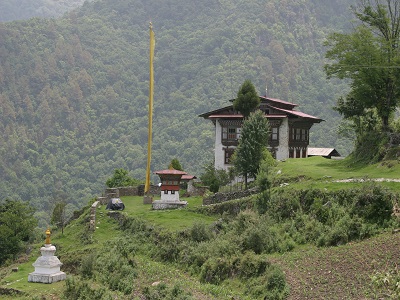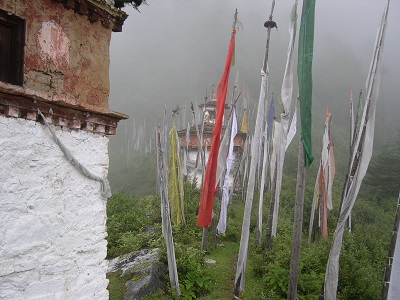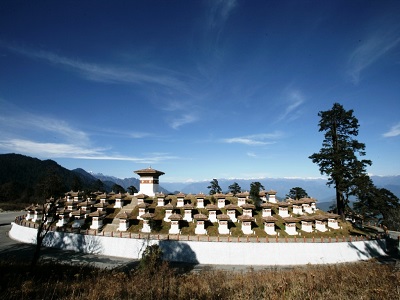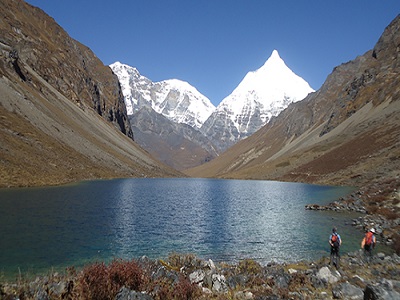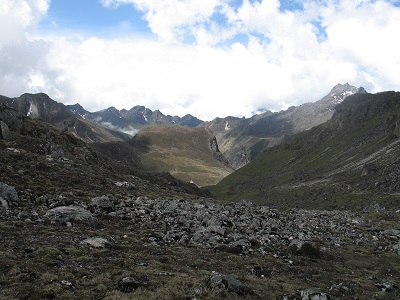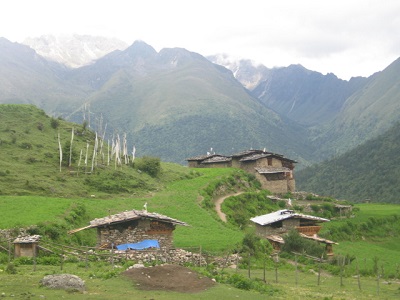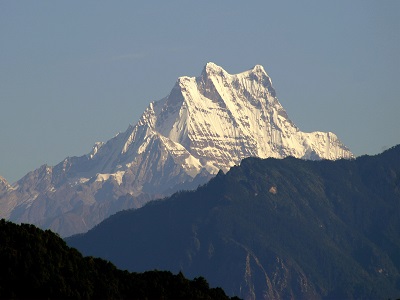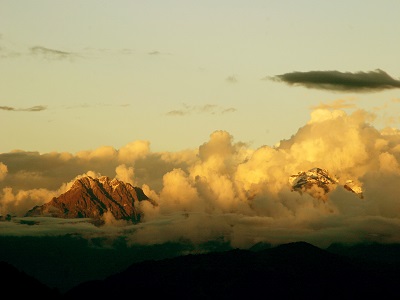
Druk Yul (Bhutanese name for Bhutan), lies east of Nepal, north of India and to the south of China occupied Tibet. With a size of 18000 sq.miles it has an altitude of 162m in the south to some of the highest unclimbed Himalayan peaks on earth.
Bhutan has long been known to be a mystical, almost forbidden Kingdom. The immense beauty of the Himalayas is contained in its diverse landscape. Cascading rivers, conifers, wild rhododendron and blue poppies, long sweeping valleys, fields of maize and tall, imposing white-capped peaks: these are only a few poetic references.
The intangible natural beauty, an intact environment, a unique culture, tradition and religion makes this tiny kingdom one of the hotspots of the world.
The People
Its 7,50,000 population mostly dwell in boundless valleys of the nation’s 20 districts. Bhutan’s indigenous population is the Drukpa. There are three main ethnic groups: Sharchops, Ngalops and the lhotshampas makes up today’s Drukpa – the inhabitants of Druk Yul.
Bhutanese are traditionally rural dwellers and their homes and villages reflect their rich history. Bhutanese homes are built to stand up to long arduous winter. They are all built of mud and wood, it seems more like natural growths than work of man. Symbols are painted on almost all homes to bring fertility to the home or prevent evil spirits from entering.
Religion
The Bhutanese are deeply religious and they are the last of the Mahayana Buddhism. Colorful monasteries and temples dot the mountain sides of the valleys. Throughout Bhutan, from the most densely populated valleys to the most remote mountain ways top, religious monuments and symbols bear witness to a deep and respected faith. Besides the farmer, the civil servants, the others bulk of Bhutanese society are comprised with the monk body.
Playing a role that is as significant as that of the temporal system, the monk body is housed in the formidable Dzongs or fortresses. It is organized into an ancient system of spiritual hierarchy headed by the Jekhenpo or head abbot. The monk is invaluable to the laity and performs all religious ceremonies.
The Land
The nation has three distinct zones, ranging from the tropical to the alpine. In the south, lush tropical forests replete with orchids and giant liana cover the land. Elephant, Tiger, wild buffaloes, bison, rhinoceros and the deer roam here at will.
This zone also boasts of the golden langur, unique to Bhutan. Higher up, the tropical forests of teak and bamboo give way to oak, maple, birch and chestnut trees. Then comes the conifer forests of pine, larch and giant cedars, interspersed with a wild variety of rhododendrons and wild azaleas. Bears, sambar, leopards, wild boars and pheasants are also found around here.
Over looking these zones is alpine belt, comprising stunted rhododendrons and azaleas, gentians, primulas, saxifrages, iris and turquoise poppies. This belt is home to musk, blue sheep and domestic yak. The takin, another unique animal in Bhutan also live here.
Democracy
The Himalayan kingdom of Bhutan is set to emerge as a parliamentary democracy with a constitutional monarchy on top. The first draft of a new constitution is ready for “extensive deliberation” before it is adopted with necessary changes.
The national assembly, largely symbolic so far, will debate the draft but the salient features of the constitution will be circulated to grassroots bodies for a “thorough debate”. Officials working on the draft for the constitution say King Jigme Singye Wangchuk is keen that Bhutan should evolve as a parliamentary democracy, but efforts are being made to adopt the model that best suits the Bhutanese people. The Constitution Drafting Committee has 39 members and is chaired by the chief justice of Bhutan’s Supreme Court.
Money/Currency
Currency of Bhutan is the Ngultrum (Nu.). The Ngultrum is fixed to the value of Indian rupee and approximately Nu. 55 make USD 1. Tourists are advised to carry their money in form of travelers’ checks (preferably American Express) with cash (US Dollars) which might be needed for incidental expenses.
Credit Cards
Credit Cards in Bhutan are inadvisable, but few handicrafts and shopping malls accept VISA & American Express Credit Cards.
Time
Bhutan time is 6 hours ahead of GMT and 30 minutes ahead of IST. There is only one time zone throughout the country.
Language
Dzongkha is the National Language of Bhutan. English is commonly spoken in few towns and also it is the medium of education in schools throughout the Kingdom.
Accommodation
There are comfortable hotels, lodges, guesthouses and luxury hotels (Taj Tashi Thimphu, Aman Kora Paro, UMA Paro, Zhiwaling Hotel) at tourist destinations. Western Bhutan has better hotels while in central and eastern part of the country, accommodation establishments are simple and offer minimum facilities. Dragon Trekkers and Tours have carefully selected a list of accommodation units with the best of location, services and ambience. Away from the towns and villages there are purpose-built huts on some of the principal trekking routes. Otherwise, there is nothing like camping out under the clearest night skies that you have ever seen. Wherever you spend the night, the warm Bhutanese hospitality will make you feel welcome.
Tour Escorts
All tours organized by Dragon Trekkers and Tours are escorted by well trained, knowledgeable and English speaking guides Certified by Tourism Council of Bhutan. The services of Japanese, English, German and other languages-speaking guides could also be provided with prior information and on additional cost.
Food
Bhutanese delicacies are rich with spicy chilies and cheese. Dragon Trekkers and Tours have a list of selected hotels and lodges which offers delicious Chinese, Continental, Bhutanese and Indian Cuisine. Even on treks, Dragon Trekkers and Tours will provide you with well trained cooks who will prepare dishes suitable to western taste ranging from Continental to Chinese and Bhutanese to Indian.
Climate
The central valleys of Punakha, Wangdiphodrang, Mongar, Trashigang and Lhuntsi enjoy a semi tropical climate with very cool winters, while Thimphu, Trongsa and Bumthang have a much harsher climate, with heavy monsoon rains in the summer and heavy snow-fall in the winter, which often blocks the passes leading into the central valleys.
Winter in Bhutan is from mid-November until mid-March, and at this time of the year the climate is dry, with daytime temperatures sometimes falling below zero Celsius. The monsoon usually arrives in mid-June, with the rain falling mainly in the afternoons and evenings. At the end of September, after the last of the big rains, autumn suddenly arrives, and is a magnificent season for trekking until November. The southern part of Bhutan is tropical, and in general the east of Bhutan is warmer than the west of the country.
Clothing
For protection against cold-layered clothing is better than a few thick ones, so choose your cloths accordingly. We advise our visitors to carry cloths preferably made from natural materials, which allow the body to breathe better. You will be offending people if you walk around in skimpy or tight fitting clothes. Although there are normally opportunities to wear shorts, we would advise women to wear skirts or loose trousers, men should not wear singlet. During visit of Monasteries, Dzongs (Fortress) and other religious institutions we advise our visitor not to wear shorts & hats.
Other then clothing, we advise you to have carried with you a pair of sunglasses, spare contact lenses, a pair of casual shoes, extra camera films and other accessories.
Photography
The photographic opportunities on all trips are immense. You will also wish to record the local people, their houses and shops etc. Always ask by gesture if it is ok to do so. Don’t take your destination as living museum. While visiting Dzong, Monasteries, Religious institutions and Museums, please follow your guide’s instruction carefully and always ask your guide if it ok to take pictures in those areas. Slide film is more difficult to find. Bring enough batteries if you use lithium batteries.
Shopping
Buying and selling of antiques is strictly forbidden in the Kingdom. You may buy country’s postage stamps for your own collection, hand woven fabrics, woven baskets, wood made products as bowls, status and etc, handmade paper, scroll paintings (Thangkas) and other available goods.
Gratuity
In general, tipping is neither compulsory nor there is any fixed amount and the bottom line in determining whether and how much to tip is to ask yourself how much the individual did to make your travel more enjoyable.
Electricity
In Bhutan, electricity runs 220/240 volts. If you do bring electrical appliances, take along an international converter kit complete with a set of adapter plugs.
Smoking or Use of Tobacco Products
Use of Tobacco products is prohibited and illegal in Bhutan. If you are a tobacco user, then you are allowed to get few amounts for your personal usage after you pay 200% tax. We would let you know more on your inquiry about this.


